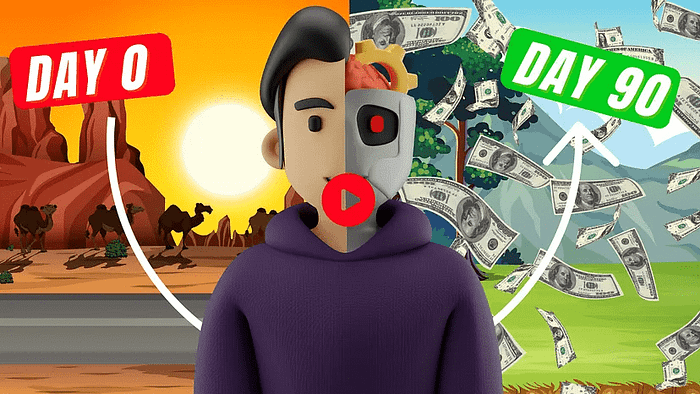I Built OpenAI’s Personal AI Agent in 1 Hour Using No Code: A Complete Guide
Revolutionizing the way we interact with artificial intelligence, my journey of creating a Personal AI Agent showcases how accessible cutting-edge technology has become for everyone, regardless of their coding expertise.
The fascinating world of AI assistants has taken a dramatic leap forward with OpenAI’s latest innovations, and I’m excited to share how I constructed a powerful Personal AI Agent that rivals their impressive demonstration – all without writing a single line of code.
We strongly recommend that you check out our guide on how to take advantage of AI in today’s passive income economy.
Table of Contents
Understanding the Architecture Behind the Personal AI Agent
The fundamental architecture of this Personal AI Agent system consists of several interconnected components that work seamlessly together. At its core, the system utilizes speech-to-text conversion, natural language processing, and advanced AI models to create a fluid conversational experience.
The Core Components
The Personal AI Agent operates through a sophisticated yet streamlined process that begins with voice input and ends with intelligent action execution. The system architecture employs a speech-to-text model, which could be OpenAI’s Whisper or similar solutions, transforming verbal commands into written text.
The Large Language Model (LLM) serves as the brain of the Personal AI Agent, analyzing queries and extracting relevant entities for action. This intelligent processing enables the system to understand complex requests and determine appropriate responses or actions.
Real-Time Processing Capabilities
Modern Personal AI Agent implementations benefit from real-time API capabilities, allowing for native speech-to-speech processing. This advancement eliminates the need for separate transcription steps, resulting in remarkably low latency and natural conversational flow.
Building the Personal AI Agent System
Platform Integration
The Personal AI Agent system I developed integrates several key platforms. Telegram serves as the primary interface for input and output, while N8N functions as the workflow automation backbone, connecting various applications seamlessly.
Technical Implementation
The implementation begins with telegram bot triggers, which initiate the Personal AI Agent’s responses. The system processes both voice and text inputs through conditional logic, ensuring versatile communication options.
Memory and Database Integration
The Personal AI Agent utilizes window buffer memory to maintain conversation history, enabling contextual awareness. A Pine Cone Vector database stores contact information, allowing the agent to efficiently retrieve and manage contact details.
Advanced Features and Tools
Communication Capabilities
The Personal AI Agent possesses an impressive array of tools, including email management, calendar coordination, and task handling. These features transform it from a simple assistant into a comprehensive Personal AI Agent solution.
Making Calls and Managing Tasks
One of the most impressive features of this Personal AI Agent is its ability to make phone calls and manage complex tasks. The system integrates with various services to handle communications effectively and maintain task schedules.
Cost Analysis and Efficiency
Platform Costs
Running a Personal AI Agent system proves surprisingly cost-effective. The implementation utilizes various services with minimal expenses:
Vapi charges approximately $0.12 per minute for voice calls, while OpenAI API costs average around $0.01 per command, including transcription, embedding, and GPT-4 model usage.
Infrastructure Considerations
The N8N community version allows for self-hosting, eliminating subscription fees. When hosted on a virtual private server, the costs remain minimal, typically ranging from $20 to $30 monthly for multiple projects.
Practical Applications and Use Cases
The Personal AI Agent system demonstrates remarkable versatility in real-world applications. From scheduling appointments to managing communication, the system handles complex tasks with efficiency and precision.
Business Integration
For business environments, the Personal AI Agent excels at managing customer service interactions, scheduling meetings, and handling routine communications. Its ability to integrate with existing systems makes it an invaluable tool for modern businesses.
Future Developments and Possibilities
The potential for Personal AI Agent technology continues to expand. Future developments may include enhanced natural language processing, improved voice synthesis, and more sophisticated task management capabilities.
Scaling and Optimization
As Personal AI Agent technology evolves, opportunities for scaling and optimization emerge. Future implementations may incorporate advanced features while maintaining the no-code accessibility that makes this system so powerful.
Conclusion
The creation of this Personal AI Agent demonstrates the democratization of advanced AI technology. By leveraging no-code platforms and existing services, anyone can build a sophisticated AI assistant that rivals professional solutions.
This achievement represents just the beginning of what’s possible with Personal AI Agent technology. As these tools continue to evolve, we can expect even more impressive capabilities and applications in the future.
Whether for personal use or business applications, the Personal AI Agent system proves that powerful AI solutions are within reach for everyone, regardless of technical expertise. The future of AI assistance is here, and it’s more accessible than ever before.

We strongly recommend that you check out our guide on how to take advantage of AI in today’s passive income economy.




